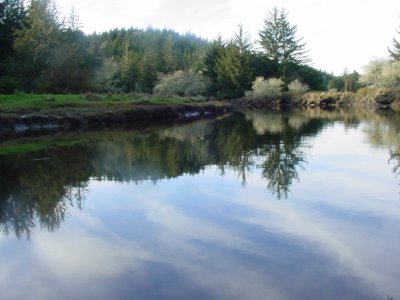
After grabbing a quick Egg-Bacon-Cheese on a Biscuit at McDonalds, we headed over to South Bend, a quaint community famous for its oyster-processing. Our canoeing destination was due west, the Bone River. It is a beautiful, pristine, gentle body of freshwater that flows into Willapa Bay.
The incoming tide of Willapa Bay combines with the nutrient-laden fresh water of the Bone river to create an extremely productive estuary. Diverse salt marshes, muddy tideflats, rain-drenched old growth forests, and coastal dunes preserves a number of unique ecosystems.
We've seen Roosevelt elk here, camped overnight with our family on Long Island, and done some exquisite filming on Leadbetter Point, where the most memorable filmed images of water are in our collection. So, I guess you could say this area is one of our favorites. Although it is only 2 hours away, we've spent weekend 'getaways' here, staying in a little motel in South Bend. The ambience of the fishing ships, the many great restaurants, and the great canoeing opportunities always draw us back, every year.
An average of 110 inches of rain falls each year here, carrying nutrients into Wallapa Bay. Chum, chinook, and coho salmon spawn in the streams. Eelgrass is the staple food of brant, a sea goose that migrates along the Pacific Coast. We saw flocks of Canadian Geese, ducks and shorebirds. Along the Bone River there were river otter and muskrat slides down into the water.
Sitka Spruce line the water's edge, and the eelgrass has sprouted about 4 inches, looking like a groomed golf-course in some places. The terrain got more and more remote and varied as we paddled up the river. There was brilliant sunshine, and no wind, so we had excellent canoeing conditions and it was a great, peaceful glide.
I was concerned about our put-in point, as the tide was going out when we started - this can pose a problem when returning, as the mudflats drain and become 'mucky'. It is a challenge to find a solid place to step out. We've had many disasters doing this, mainly getting stuck and muddy in the process of getting out. But, that is all part of the process, and a risk that is taken.
I felt the concern, so I disembarked on a little stony beach; George wanted to go further down about 30 feet, and by the time I'd climbed up the cliff onto a hill, I could see that he was in trouble. I told him to go back, to get out where I did, as it was dry....but, he went his own way, and promptly got bogged down in a foot of sucking mud.
Now there is the problem of 'men'. You don't want to be telling them how to do things when they realize they didn't take their wife's suggestion, especially if they are mired up to the top of their boots. And, their feet are so twisted they can't move. And, they've had to sit down in the bottom of the canoe, cold water soaking into their britches. And they are trying to catch their breath from twisting, turning, pulling and cussing.
I had to climb back down from my safe place and use my paddle to dig him out. Then I demanded that he give me the rope I keep handy for such occasions, which enables me to save my canoe, if not my husband. I pulled the canoe up the bank while George flipped it over, and together we got 'er done. But, we both smelled like sewage when we were finished, with mud all over our pants and jackets.
When George had recovered from his anger and embarrasment, I told him that a person on a cliff has a better vantage point to see the full scope of a predicament. A person who is angry and in a dire situation needs to listen to the person who is calm, reasoned, and safe. He wouldn't admit this, right away, but after he'd recovered, he saw the sense of what I was talking about. (And you can bet I did some talking!)
After this 'rescue attempt' of mine, I'm determined to carry a long 2" by 12" board in the canoe - so that if George doesn't follow my suggestion, he can just slide up the darn thing on his belly. I've learned something from watching those belly-sliding river otters.